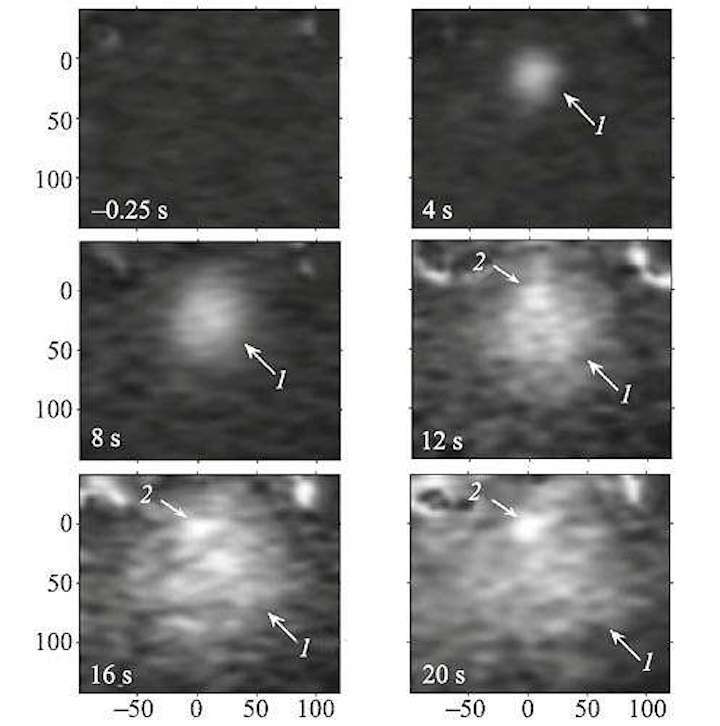26.01.2019

Photographs of the region where the meteoroid collides at the point (0, 0) with the surface of the Moon taken at 0.25 s before the collision and at 4, 8, 12, 16, and 20 s after the collision. The axes present distances in kilometers. Arrows 1 and 2 indicate the fast large and slow small dust clouds, respectively.
Physicists from the Higher School of Economics and Space Research Institute have identified a mechanism explaining the appearance of two dusty plasma clouds resulting from a meteoroid that impacted the surface of the Moon. The study was published in JETP Letters.
The collision of a meteoroid with the surface of the Moon greatly changes the properties of the surrounding dusty plasma system by throwing a large quantity of lunar soil-regolith debris - dust particles measuring 10-100 microns - into the otherwise relatively unsullied exosphere.
In 2015, astronomers at the Garden Observatory in Gordola (Switzerland) observed a similar phenomenon when they recorded an optical flash resulting from a meteoroid impacting the Moon. An international group of scientists using data from astronomical observations concluded that a fairly large and fast-moving meteoroid hadimpacted the Moon, raising two clouds of unknown composition.
Russian researchers from the Higher School of Economics, Space Research Institute (IKI), Moscow Institute of Physics and Technology, Sternberg Astronomical Institute, and Far Eastern Federal University determined that a meteoroid's collision with the surface of the Moon produces a shock wave that throws up regolith fragments and droplets of molten material into the surrounding free space.
Those fragments and hardened molten droplets rise above the surface of the Moon, interact with the electrons in the solar wind and solar radiation and take on an electrical charge.
Two dusty plasma clouds form as a result - one composed of regolith fragments and a second of hardened droplets of molten material. The differing characteristics of the two clouds make it possible to observe them separately.
Scientists have calculated the main characteristics of the clouds - the speed at which they expand, the size, number density, and electrical charge of the particles in each, and so on. The calculations and observational data matched. It was found that a cloud formed by hardened droplets of molten material expands significantly faster than a cloud formed by regolith fragments.
'Lunar dust is a significant risk factor for spacecraft, equipment, and the astronauts' health,' explained study co-author, HSE Faculty of Physics Professor, and Space Research Institute Laboratory Head Sergey Popel.
'Equipment covered with dust can malfunction. Astronauts carry dust on their spacesuits into the lunar module where it becomes suspended weightlessly in the air, causing them to inhale the particles during their entire return trip to Earth. Therefore, understanding the mechanism by which dusty plasma clouds are formed is important for ensuring the safety of space flights to the Moon.'
Link: https://link.springer.com/article/10.1134%2FS0021364018180091
Quelle: SD
